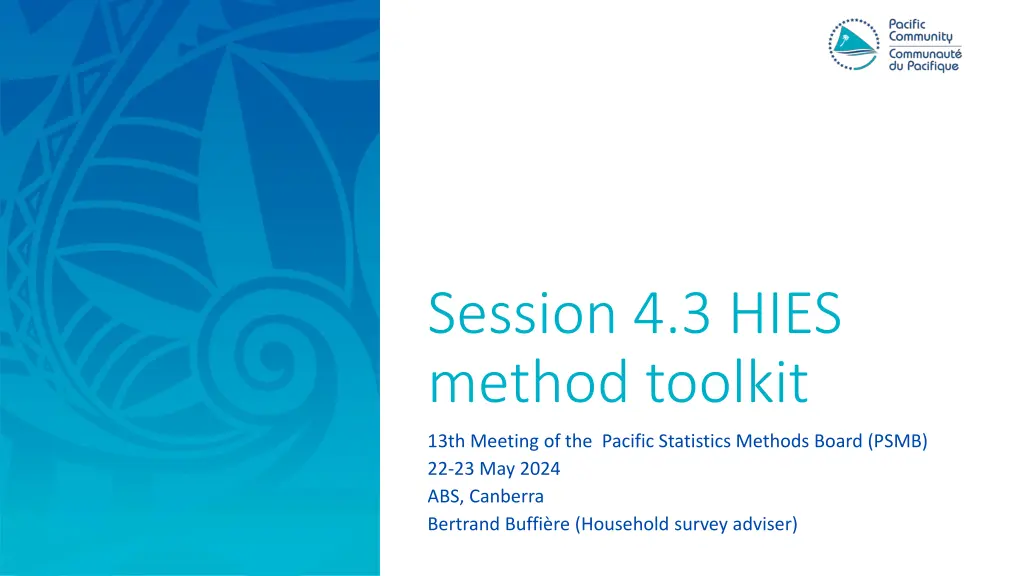
Pacific Household Income and Expenditure Survey Methods Toolkit
Explore the Pacific Household Income and Expenditure Survey Methods Toolkit, offering guidance on conducting surveys and ensuring data quality. Learn about the key steps in the survey process, from planning to dissemination, with technical advice provided throughout. Discover the main activities involved in operating a successful HIES, from setting up a steering committee to executing fieldwork effectively.
Download Presentation

Please find below an Image/Link to download the presentation.
The content on the website is provided AS IS for your information and personal use only. It may not be sold, licensed, or shared on other websites without obtaining consent from the author. If you encounter any issues during the download, it is possible that the publisher has removed the file from their server.
You are allowed to download the files provided on this website for personal or commercial use, subject to the condition that they are used lawfully. All files are the property of their respective owners.
The content on the website is provided AS IS for your information and personal use only. It may not be sold, licensed, or shared on other websites without obtaining consent from the author.
E N D
Presentation Transcript
Session 4.3 HIES method toolkit 13th Meeting of the Pacific Statistics Methods Board (PSMB) 22-23 May 2024 ABS, Canberra Bertrand Buffi re (Household survey adviser)
Purpose (1) The HIES Methods Toolkit which aims to put together various advice and teaching materials from the Pacific experience in conducting Household Income and Expenditure Surveys. It builds on the information shared with Pacific Island participants at the HIES regional conference in Nadi in 2023 and other HIES regional and sub-regional trainings (Pacstat). The toolkit has been drafted primarily by the statistical collection team (Bertrand, Toga, Winston, Olivier, Luis). This is an initial draft for PSMB feedback.
Purpose (2) Implementing a HIES is a long and complex process, which lasts overall around 3 years: one year for planning and budgeting, one year for fieldwork and one for data processing, analysis and dissemination. The quality of each step in the survey process is the main limiting factor for the following steps Achieving high standard of quality in each step is fundamental for achieving good quality data. The goal of this guidance note is to provide an outline of the main steps in the survey process, from the set-up of the survey steering committee to the dissemination and anonymisation of survey data, passing through the sampling strategy, the questionnaire design, the training of enumerators, the pilot test, the management of the field work, and data editing, preparation and validation. It provides some technical advice on all the aspects of the survey process.
Uses of the GN Similarly to the Sampling Guidance Notes, this document is intended to be a living document and additional chapters could be added in the future to cover some new issues or the emergence of new techonologies. It covers some aspects already mentioned in other GNs (dissemination, sampling, outlier detection)
Content of the GN 1. Planning survey activities 2. Field work 3. Data editing and preparation 4. Report writing 5. Dissemination and anonymisation Annex Stata Codes (tables and graphs)
Main activities related to HIES operation Preparation phase - Set up of steering committee - Questionnaire design (Core section, additional sections) and consultations - Sample strategy, sample size, random selection (see sampling GN) - Cartography, mapping - Development of the field plan (number of staff, field schedule)
Main activities related to HIES operation Field work - Staff recruitment - Development of training materials (questionnaire and fieldwork manual) - Training of enumerators (Questionnaire; CAPI) - Pilot test - Field work management, assessment & monitoring Data editing & cleaning - Coding & recoding, cleaning generation of dataset 1 - Structure of the final dataset - Data validation (see food data processing GN) - Computation of sampling weights
Main activities related to HIES operation Reporting - Tabulation plan - HIES report writing (incl. tables and graphs) Dissemination and anonymisation (see Disseimnation GN) - Documenting - Anonymising (SDC techniques) - Archiving
HIES - Core questionnaire Food component Development for the PICTs of harmonized modules on food consumption data aligned with the 2018 WB/FAO guidelines on food data collection in HCES 3 sections related to food consumption: - Household module on in-house food consumption (7 days recall) - Individual module on Food away from home (7 days recall) - Module on number of meals shared with guests (7 days) Collection of food market survey data (for the prices and weights in grams per one unit) Adoption of the FAO Food Insecurity Experience Scale (used in the estimation of SDG 2.1.2)
HIES - Core questionnaire Non-food component There are no international recommendations for the collection of non food consumption/expenditure However some non-food sections were designed in collaboration with relevant technical agencies: - health information & expenditure: WHO - labor force & income from labor: ILO
HIES - Additional sections HIES are often used as a vehicle to collect other non related information through additional sections such as: Climate change Well being Social protection Time use Deprivation etc. ! Implementation of extra sections that are not directly linked to the purposes of HIES can affect the success and the cost effectiveness of the survey by increasing the length of the interview should be adopted with caution
On-going work/collaboration Collaboration with PFTAC HIES is a unique source of information for National Account and Consumer Price Index updates. SDD is currently working in collaboration with PFTAC to improve the questionnaire design & the dissemination of the HIES to better fit NA & CPI requirements (recent regional workshop in Suva; Bertrand & Olivier) A paper in the next PSMB will be presented in this regard.
PSMB is invited to: 1. Provide advice / guidance on the content, structure and communication of the proposed HIES Methods Toolkit 2. Note that a revised version of the Toolkit will be brought to the next Board Meeting for approval.
